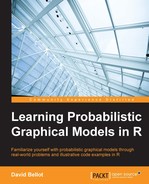Probabilistic graphical models is one of the most advanced techniques in machine learning to represent data and models in the real world with probabilities. In many instances, it uses the Bayesian paradigm to describe algorithms that can draw conclusions from noisy and uncertain real-world data.
The book covers topics such as inference (automated reasoning and learning), which is automatically building models from raw data. It explains how all the algorithms work step by step and presents readily usable solutions in R with many examples. After covering the basic principles of probabilities and the Bayes formula, it presents Probabilistic Graphical Models(PGMs) and several types of inference and learning algorithms. The reader will go from the design to the automatic fitting of the model.
Then, the books focuses on useful models that have proven track records in solving many data science problems, such as Bayesian classifiers, Mixtures models, Bayesian Linear Regression, and also simpler models that are used as basic components to build more complex models.
Chapter 1, Probabilistic Reasoning, covers topics from the basic concepts of probabilities to PGMs as a generic framework to do tractable, efficient, and easy modeling with probabilistic models, through the presentation of the Bayes formula.
Chapter 2, Exact Inference, shows you how to build PGMs by combining simple graphs and perform queries on the model using an exact inference algorithm called the junction tree algorithm.
Chapter 3, Learning Parameters, includes fitting and learning the PGM models from data sets with the Maximum Likelihood approach.
Chapter 4, Bayesian Modeling – Basic Models, covers simple and powerful Bayesian models that can be used as building blocks for more advanced models and shows you how to fit and query them with adapted algorithms.
Chapter 5, Approximate Inference, covers the second way to perform an inference in PGM using sampling algorithms and a presentation of the main sampling algorithms such as MCMC.
Chapter 6, Bayesian Modeling – Linear Models, shows you a more Bayesian view of the standard linear regression algorithm and a solution to the problem of over-fitting.
Chapter 7, Probabilistic Mixture Models, goes over more advanced probabilistic models in which the data comes from a mixture of several simple models.
Appendix, References, includes all the books and articles which have been used to write this book.
